My first day in command of the RMS "Queen of the Isles" and the problem of Cold Iron |
I had the enormous honour of being sent this recently, an excellent story of life on the Queen of the Isles circa 1970. My great thanks to Captain Eric Kemp.
All the pictures used here can be seen in more detail on the images page.
By the end of 1969 I had spent 5 years with the Trinity House Steam Vessel Service and for most of the time I had been stationed at Penzance serving as Junior and then Senior 2nd Officer in the T. H. V "Stella". It had been one the happiest times of my life involved in visiting lighthouses such as Godrevy, Longships Bishop Rock, Round Island, Eddystone and Wolf Rock to change the keepers and landing stores of fuel food and equipment. Now as Christmas approached change was in the air, my promotion was due in the New Year to Chief Officer which would have probably been to a vessel based at Harwich in Essex.So I decided to start looking around for a new job as I did not want to leave my beloved Cornwall. I already held a Foreign Going Master's certificate and I became aware that the smaller of the two ferries serving the Isles of Scilly from Penzance required a Captain. As the vessel was in Holmans dry dock at Penzance at the time I visited the Isles of Scilly Steamship Office and after an interview with Mr Henry Thomas the managing director I landed the job. |
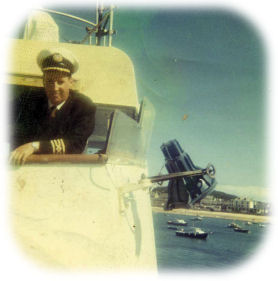 |
|||||
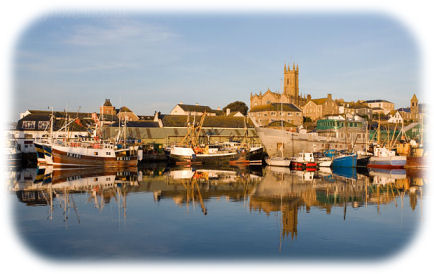 |
I joined the ship in the third week of January 1970 taking up the temporary position as Chief Officer under Captain Ashford who was due to be promoted to company superintendent based at Hugh Town on St Mary's in the islands. The "Queen of the Isles" had been built at Charles Hill's Albion Yard Bristol and because of a very cheap tender price was reputed to have been the main reason behind that company closing down. I now learned that she had run at a loss for four years since arriving at Penzance and her future was uncertain. (I remain proud of the fact that during the year of 1970 she made a profit, but that's another story.) |
|||||
Overall the "Queen of the Isles" was 156 feet in length a beam of 30 feet and a draft of 10 feet loaded. Her gross tonnage was 515 tons and powered by 2 Ruston Hornsby Engines, her twin propellers gave her speed of 15 knots. The vessel could carry 300 passengers and 60 tons of cargo. My first visit to the bridge proved a revelation, the ships navigational equipment was basic in the extreme, a magnetic compass to steer by as well as another compass on the deck above the Wheelhouse. The company's pride and joy was the Decca Radar with a poor 40 mile range but would give good results at 12 miles and less. Mr Thomas was of the opinion that the vessel would be able to keep perfect timing for the passengers with such a good navigational aid in fog! I spent over a half an hour searching for other equipment such as an echo sounder(which gives the depth of water under the ship at any time) without result, and there was only an old fashioned medium frequency radio in a small space at the rear of the bridge close to the chart table. |
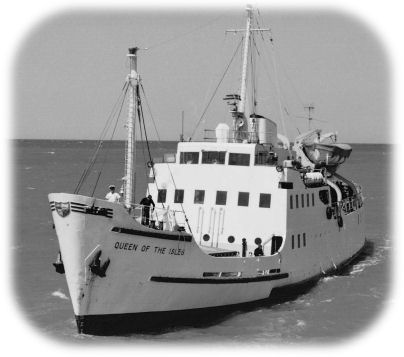 |
|||||
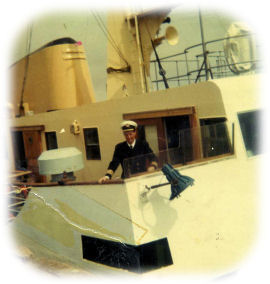 |
My cabin just behind the bridge however was spacious and comfortable and I was as keen as mustard to take over my new ship as soon as possible. During the coming days I had to take two examinations to discover whether my knowledge of Pilotage at Penzance and the Isles of Scilly was adequate to assume the responsibility to safe guard the ship, crew and passengers. This I was able to do as soon as I had accomplished a set number of trips to and from the Islands. After finishing the refit I was to spend six weeks running between Penzance and St Mary's. As the "R M S Scillonian" was the senior vessel 6 nights a week were spent in Penzance while the Queen of the Isles had only one, spending the other 6 nights at St. Mary's. So I did not see my wife and young family a great deal during this time. However, finally in March the day dawned when I could take over my new command. |
|||||
The "Queen of the Isles" had a summer crew of 12 persons, my temporary Chief Office at the time was Sam Guy an islander with extensive knowledge of the operating area. The chief engineer and 2nd Engineer officers John Allen and Robert Cray were both local and very dependable. The bosun Harry Skewes always took the wheel on entering harbour or in difficult situations. The deck crew consisted of 4 seamen, Colin Downing, Colin Nichols, George McBurnie and John Le Breton; while the catering crew consisted of Jerry the purser/steward and Wilfred the cook. A stewardess joined us later in the season when there were more passengers |
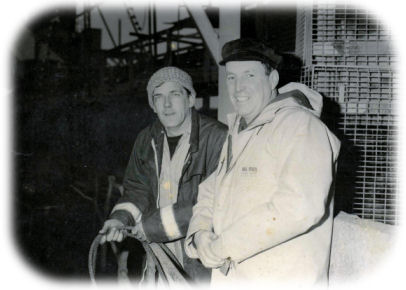 |
|||||
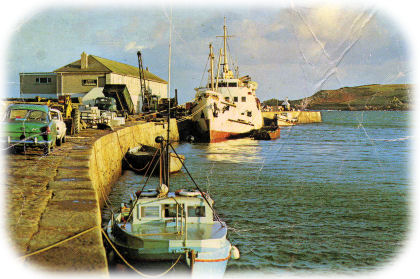 |
On that March morning the weather was calm and the sun rose to the south east of St Mary's showing the magnificent scenery of the islands at its very best with the sparkling sea inviting a short cruise to Penzance. While the dockers loaded 1400 boxes of flowers for the mainland and the crew prepared the ship for sea I was up early to hear the BBC radio shipping forecast at 6 30 am. My heart sank as the announcer predicted rain and increasing south westerly winds for the forecast areas Plymouth, Lundy and Sole later in the day. We were scheduled to sail from St Mary's at 9 30 am and arrive at Penzance lighthouse pier at 12 15 pm. Departing from there at 4 pm the ship was due to arrive back at St Mary's at 7 o'clock one and a half hours before low water. On the previous evening we had moved the ship to the outer end of the quay at St. Mary's to allow for the low water spring tide being so close to departure time from St. Mary's. |
|||||
Alongside the end of the quay there was a narrow channel of slightly deeper water and this move ensured that we were not aground at the time of our leaving. Now if there was a delay caused by bad weather my problems in berthing the ship would make it much more difficult to get alongside if the ship was late in returning. The low water then was just after 8 30 pm, so at that time there would be very little water to get the ship alongside and allow the passengers to disembark. So I had to try and hurry things along during the day if possible. Just after 9. 25 we had completed the loading of the cargo and some 15 passengers had come aboard. Our hatch was covered and we were ready to proceed when the bosun arrived on the bridge to take the wheel. His face was a picture of misery and to say the least and I was alarmed at what could have gone wrong. |
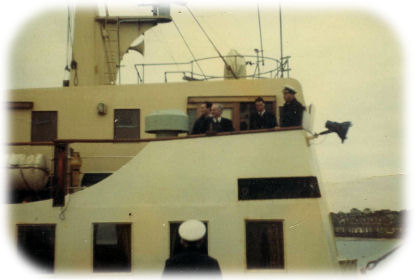 |
|||||
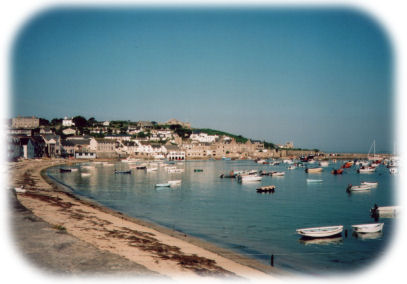 |
Harry announced as he took up his position "It’s all going to be a disaster today", "Why what's happened?" I demanded. "Cold Iron, we have a monk from Buckfastleigh Abbey in all his robes as a passenger and its bound to go wrong in the case of a sky pilot on board" he said gloomily. So of course I smiled and dismissed his words with an loud "Nonsense old wives' tales Harry" but I was wondering as I backed the Queen off the quay and turned into the channel and worked our way out of the islands passing the Bartholomew and Spanish Ledges Buoys as well as the Woolpack Beacon before setting our course for the Cornish mainland and Penzance. As it happened all went well at first with a gentle south west wind pushing us on and we made excellent progress towards our destination. By noon we were approaching the lighthouse pier at Penzance and I was well pleased with our progress, even Harry seemed mollified as we came alongside and the discharge of the boxes of flowers began. |
|||||
The monk together with the other passengers shuffled away up the pier towards the town, his sandals slapping on the granite stones as he did so. By then I had conferred with the foreman docker Ben Green explaining the need to sail on time. He reassured me that there was not too much cargo to load and estimated that we would easily be on our way by 4 pm. So with a light heart I left Sam the Chief Officer in charge and went home to St. Ives for a quick midday meal with my family. On my way back to Penzance after a very pleasant meal I noticed that the clouds were gathering and the wind was rising. To make it worse, on arrival at the lighthouse pier, I found that there had been a late rush of extra cargo and Ben Green was to say the least, flustered. "No way Captain" he said "You will be late in sailing, in fact you will have to take some deck cargo as well, we will be filling the hold completely." |
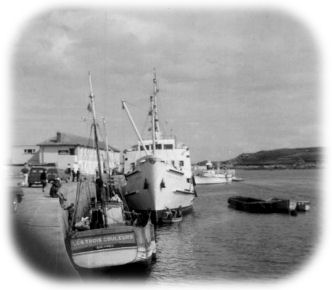 |
|||||
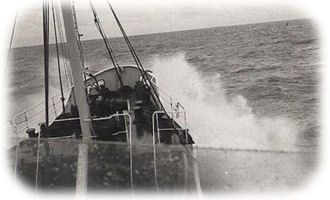 |
Sam was preparing the lashing for the cargo so I went down to the Chief Engineer to see if he would give me some extra speed. "No way Captain" he said we have one or two small problems and I do not recommend pushing the ship at the moment. After all you wouldn't want the vessel to break down on her way over would you?" I had no answer to that one and so I made my way back to the bridge and looked with concern at the now worsening sea conditions in Penzance Bay. At 3 50 pm that afternoon things got even worse as Harry with a really grim face checked our monk back on board as a return passenger to the Islands. With our cargo now on board and the 10 or so passengers warned of the bad weather to come, we left the pier as the wind increased to near gale force. |
|||||
Just before 5 pm and very shortly after passing the Low Lee Buoy near Mousehole, the ship began to pitch into the increasing sea with considerable violence. Already some of our passengers were suffering sea sickness and things got worse as we struggled past the Runnelstone buoy and out to the area of the Wolf Rock Lighthouse. Just after 6 30 pm a large container of petrol broke loose on the foredeck. This meant almost stopping the ship to ease the motion and give the Chief Officer Sam and the crew a chance of catching and restoring it to a safe position. So another 20 minutes were lost and now as I approached the Islands it was pitch black with rain reducing the visibility, but the shelter of the land giving us some protection from the now gale force south west wind. At Hugh Town on St Mary's the company had arranged the leading lights to be on to help us to stay in the Channel as we approached the quay, but it was now just 10 minutes after low water. |
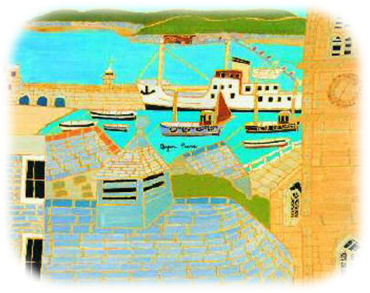 |
|||||
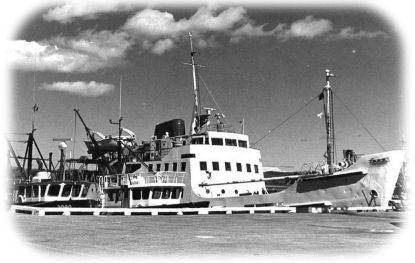 |
My problem was fairly simple I had to approach the quay at a right angle and turn into the deeper water by the quay without grounding on the bank less than a hundred feet away. "It’s that Monk; he's Cold Iron "said Harry as we approached the turn. As the ship turned across the wind she became very difficult to manoeuvre and sure enough the bow grounded on the bank as we missed the narrow channel entrance. As I battled to get the stern which was still afloat towards the quay, Colin Downing came to my aid and in the end proved Harry wrong in his gloomy predictions. Standing on the stern deck his feet wide apart he threw a magnificent heaving line attached to a mooring rope across the gap onto the quay. Willing hands there soon pulled in the rope and made it fast on a bollard. We were able to get the stern very close to our berthing position. Then before trying to get the bow afloat once more we placed a gangway stored on the quay down onto the stern deck and ushered the Monk ashore with all dispatch, followed by his fellow travelers. Some 15 minutes later and after quite a struggle we had refloated and got alongside. It had been quite a day and yet we had arrived with our passengers and cargo in good order. It was to be a good start to a busy year which was to end in disappointment but as I said before that's another story!. |
|||||